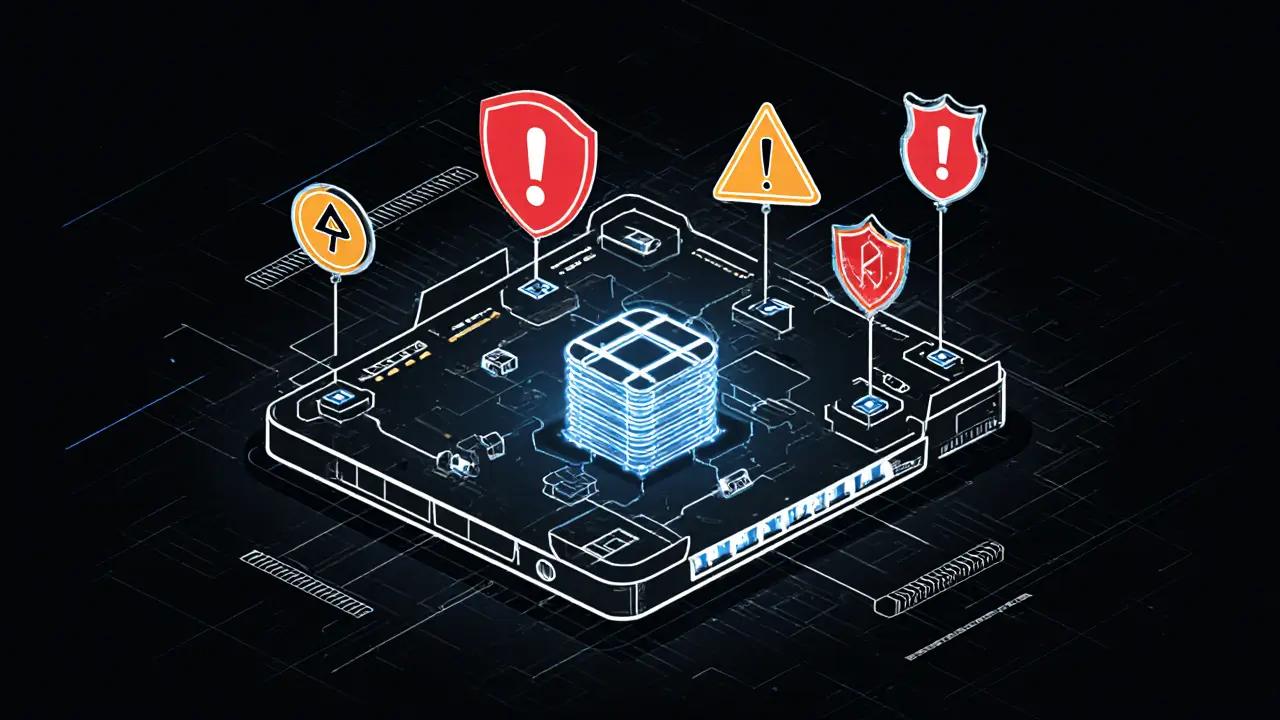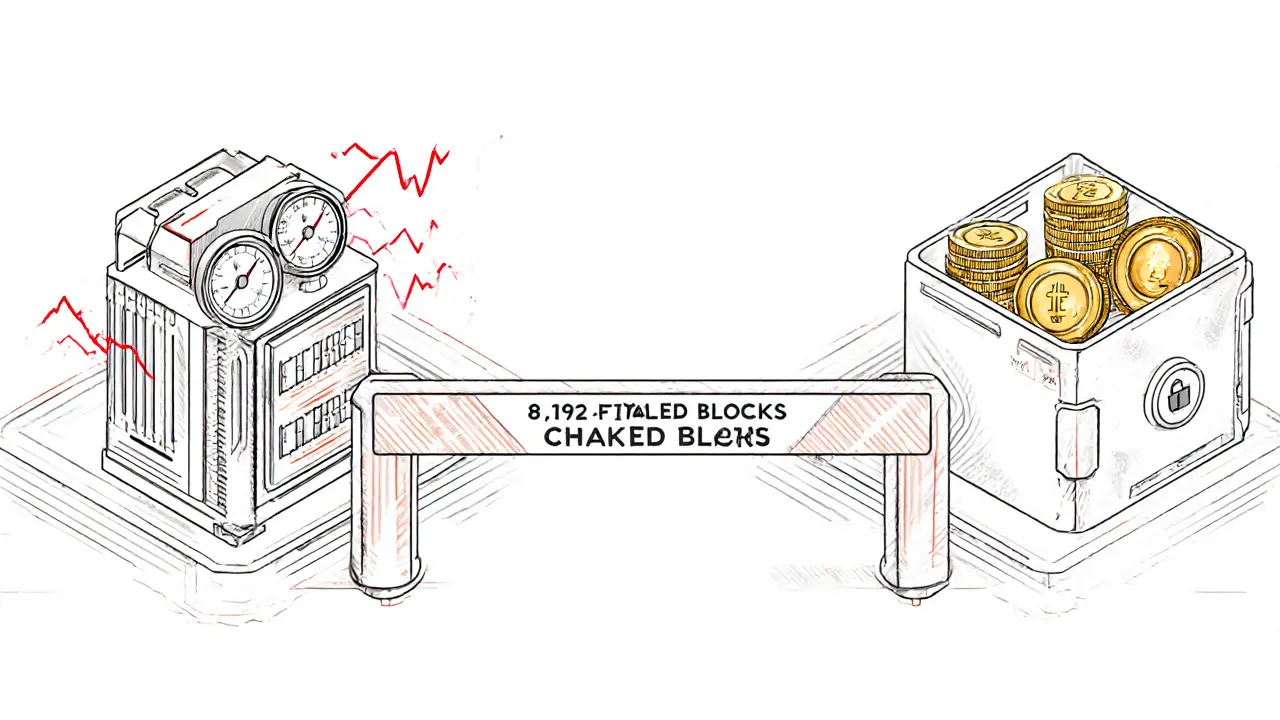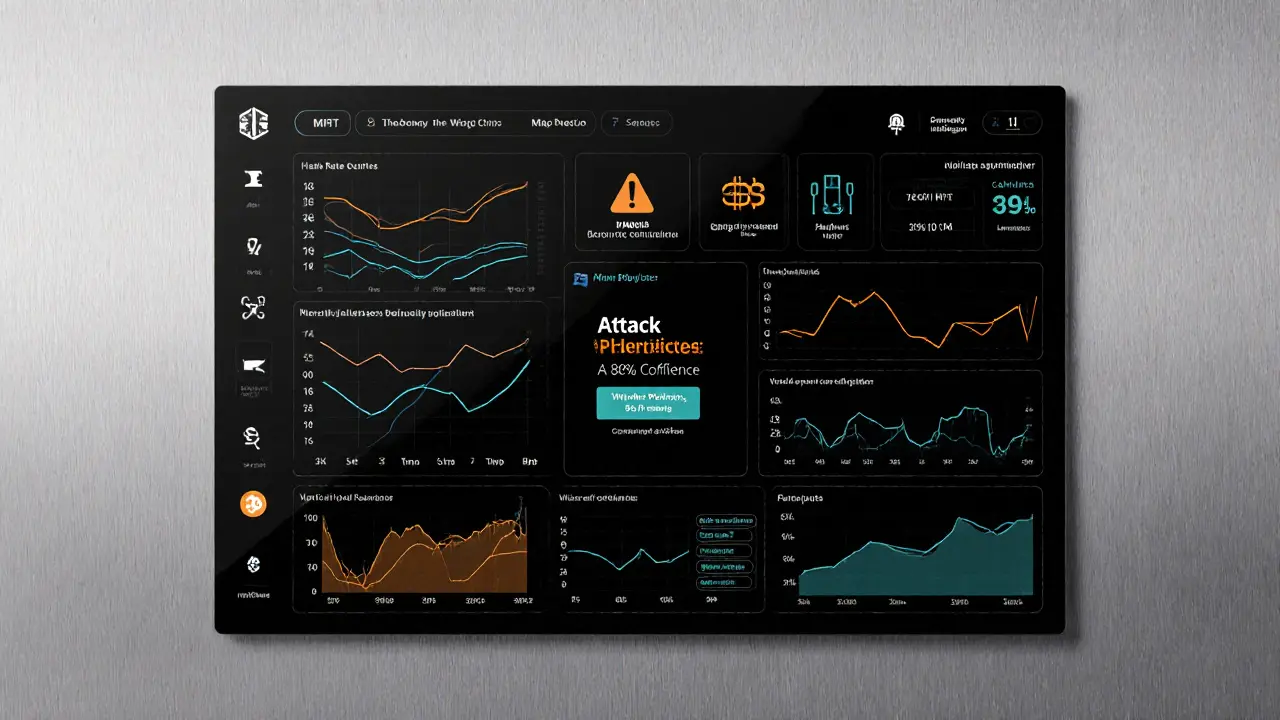How to Prevent 51% Attacks on Blockchains: Real-World Strategies for Network Security

51% Attack Cost Calculator
This calculator estimates the cost to mount a 51% attack on various blockchains. It uses real-world data from the article to show how economic factors make some networks vulnerable while others remain secure.
Note: These calculations are based on current market conditions and may change. A successful attack could cause market crashes, so the actual cost may be higher than calculated.
What a 51% attack really does to a blockchain
Imagine you wake up one morning and find out someone erased your last five Bitcoin transactions-your payment to a vendor, your deposit to an exchange, even your last withdrawal. All gone. Not because you made a mistake. Not because of a hack. But because someone else controlled the network long enough to rewrite history. That’s a 51% attack.
It doesn’t require supercomputers or magic. It just needs more computing power than everyone else combined. In proof-of-work blockchains like Bitcoin, that means controlling over half of the total mining hash rate. In proof-of-stake chains like Ethereum, it means owning more than half of all staked tokens. Once that threshold is crossed, the attacker can block new transactions, reverse confirmed payments, and double-spend coins. The blockchain doesn’t break. It just becomes untrustworthy.
And it’s happened. More than 40 times since 2019. Not on Bitcoin. Not on Ethereum. But on smaller coins: Bitcoin Gold, Verge, Litecoin Cash. In 2020, Verge lost $1.7 million in a single attack. In 2022, Ethereum Classic had 3,631 blocks reversed, freezing deposits on Binance for three days. These aren’t theoretical risks. They’re real losses, happening right now to coins nobody’s watching.
Why small blockchains are easy targets
The bigger the network, the harder it is to attack. Bitcoin’s network requires about 400 exahashes per second (EH/s) to control. That’s roughly $12.7 billion in mining hardware and $48 million in daily electricity. No individual or even a nation-state can afford that-unless they’re willing to lose more than they steal.
But look at a coin with a $20 million market cap and only 0.6 EH/s of hash power. Renting enough computing power to take it over costs less than $1,500 on NiceHash for a few hours. That’s cheaper than a used car. And that’s exactly what attackers do. They rent, attack, cash out, and disappear. The network recovers. The coin’s price drops. Users lose money. And the attacker walks away clean.
Chainalysis found that 87% of all 51% attacks target blockchains with market caps under $50 million. Why? Because the cost to break them is lower than the reward. It’s not a flaw in cryptography. It’s a flaw in economics. If the value of the asset doesn’t justify the cost to defend it, someone will try to break it.
How Proof-of-Work networks fight back
Bitcoin doesn’t just rely on size. It has built-in defenses. Since 2016, Bitcoin Core developers have monitored mining pools. If any single pool hits 40% of the total hash rate, alerts go out. The community reacts. Miners move. Pools split. The network self-corrects.
Some newer PoW chains use extra layers. The MIT-developed ChainLocks protocol, for example, requires 60% of miners to sign each block. Even if you control 51% of the hash rate, you still need 60% of the signers. That’s nearly impossible without controlling the mining hardware itself-and even then, it’s risky. If you’re caught, your hardware gets blacklisted. Your investment vanishes.
Another trick? Block time monitoring. MIT’s Blockchain Security Monitor watches for sudden spikes in block creation speed. If blocks start appearing every 20 seconds instead of 10 minutes, it’s a red flag. The system flags it, exchanges freeze deposits, and users get warned. In 2023, one Ravencoin miner triggered a false alarm after accidentally overclocking their rigs. The network paused for 47 minutes while they checked it. Not perfect. But it stopped a potential attack before it started.

How Proof-of-Stake networks stop attacks before they start
After Ethereum switched to proof-of-stake in September 2022, 51% attacks became a lot harder. Why? Because you don’t rent hardware-you buy tokens. To control 51% of Ethereum, you’d need to buy over 17 million ETH. At $3,200 per ETH, that’s $54 billion. You’d crash the market before you even started.
But it gets better. Ethereum uses slashing. If a validator tries to cheat-like signing two conflicting blocks-they lose part of their stake. The more they cheat, the more they lose. In late 2022, a group tried to control 35% of Ethereum’s validators. They didn’t even get close to 51%. But the slashing mechanism still punished them for misbehavior. They lost millions. The network kept running.
Cardano and Solana use similar rules. Validators must lock up large amounts of native tokens. And if they act maliciously, those tokens are destroyed. It’s not just expensive to attack. It’s financially suicidal.
There’s one catch: long-range attacks. If someone holds 66% of staked tokens for over two weeks, they could theoretically rewrite the entire chain from the beginning. That’s why most PoS chains use checkpointing. Ethereum, for example, freezes the last 8,192 blocks as unchangeable. Even if you control 90% of the stake, you can’t touch those blocks. History becomes permanent.
Hybrid models and enterprise blockchains
Some blockchains mix both worlds. Decred uses 60% proof-of-work and 40% proof-of-stake. In a 2021 test, researchers tried to control 65% of the network. They failed. Why? Because you’d need to control both the miners and the stakers. Two separate systems. Two separate costs. It’s like trying to break into a bank by stealing the keys and the vault code.
Enterprise blockchains like Hyperledger Fabric don’t even use mining or staking. They use Practical Byzantine Fault Tolerance (PBFT). In PBFT, a network of trusted nodes vote on each block. As long as two-thirds of the nodes are honest, the system works. Even if 33% are compromised, the network keeps going. That’s why 72% of Fortune 500 companies use permissioned blockchains-they don’t need decentralization. They need reliability.
And they’re right to. Gartner’s 2023 security rating gave Hyperledger Fabric a 92/100. Bitcoin? 78/100. Not because Bitcoin is weak. But because public blockchains are open to anyone. And that openness is a double-edged sword.

What you can do as a user or developer
If you’re a user: avoid small, low-market-cap coins. If a coin’s price is under $50 million, assume it’s vulnerable. Don’t store large amounts on exchanges that support those coins. Wait for at least 10 confirmations before considering a transaction final. On Bitcoin, that’s about 100 minutes. On Ethereum, it’s 15 seconds. But on a small PoW chain? Wait 24 hours. Better safe than sorry.
If you’re a developer building a new blockchain: don’t launch with fewer than 1,000 mining nodes (for PoW) or 1,024 validators (for PoS). Distribute them across at least six continents. Use economic penalties. Use checkpointing. Use community voting. Don’t rely on size alone. Size helps, but structure matters more.
And if you’re running a mining pool or stake pool: never let your share go above 30%. If you hit 40%, voluntarily reduce your capacity. The community will thank you. And you’ll avoid becoming the target.
The future of 51% attack prevention
Things are getting better. Ethereum’s Dencun upgrade, coming in early 2024, will separate block proposers from block builders. That means no single entity can control both the order of transactions and their inclusion. It closes a hidden centralization risk that could lead to 51% vulnerabilities.
MIT’s new AI-powered monitor, released in October 2023, can predict attacks before they happen. It looks at hash rate trends, mining pool behavior, and even rental market data. In testing, it flagged 89% of attacks before they occurred. That’s huge.
Regulators are catching up too. The EU’s MiCA law, effective June 2024, forces all crypto services to prove they can detect and prevent majority attacks. No more excuses. No more ignoring the risk.
By 2027, experts predict attacks on networks with market caps over $1 billion will drop to under 0.5 per year. Right now, it’s 2.3. Progress isn’t perfect. But it’s real.
Bottom line: Security is a team sport
No single fix stops a 51% attack. It’s not about one algorithm. It’s about economics, community, infrastructure, and timing. A blockchain is only as secure as its least trusted participant. That’s why decentralization isn’t just a buzzword-it’s the only thing that keeps the system alive.
Big networks are safe because they’re expensive to attack. Small ones aren’t. Users need to know the difference. Developers need to build with defense in mind. And the whole ecosystem needs to act like a team-not a collection of isolated projects.
Because when a blockchain loses trust, it loses everything.
Can a 51% attack happen on Bitcoin?
Technically, yes. But practically, no. Bitcoin’s network requires over $12 billion in hardware and $48 million in daily electricity to control. No entity has that kind of capital, and even if they did, the cost of the attack would far exceed any possible gain. Plus, the community would quickly respond-miners would leave, exchanges would halt trading, and the network would fork to invalidate the attacker’s blocks. Bitcoin’s size is its strongest defense.
Is proof-of-stake completely immune to 51% attacks?
No. While PoS makes attacks much harder, it’s not impossible. To control 51% of Ethereum, you’d need to buy over $50 billion worth of ETH. That would crash the price before you finished buying. But if you already owned that much, you’d be losing more than you’d gain. Slashing penalties make it even riskier. Still, long-range attacks-where an attacker controls >66% of staked tokens for weeks-are a theoretical concern. That’s why checkpoints and finality layers exist.
Why do most 51% attacks target small cryptocurrencies?
Because they’re cheap to attack. A coin with a $20 million market cap and low hash rate can be rented for under $1,500 for a few hours. The attacker double-spends, cashes out, and disappears. The cost to defend is higher than the value of the coin itself. It’s not a bug-it’s a market failure. Small coins lack the economic incentives to secure themselves properly.
Can exchanges prevent 51% attacks?
Not directly, but they can reduce damage. Exchanges like Binance and Coinbase monitor blockchain reorganizations. If a chain reorg exceeds 10 blocks, they freeze deposits and withdrawals. They also delay finality for small-cap coins-requiring 50+ confirmations instead of 6. This gives the network time to recover and users time to react. They’re the last line of defense for everyday users.
What’s the best way to protect my crypto from a 51% attack?
Don’t hold large amounts in small, low-market-cap coins. Stick to Bitcoin, Ethereum, and other networks with market caps over $1 billion. Wait for at least 10 confirmations on Bitcoin, and 15+ on smaller PoW chains. Use exchanges that have clear reorg policies. And never trust a transaction as final until the network has had time to confirm it-usually 10 minutes to 24 hours, depending on the coin.

vinay kumar
November 19, 2025 AT 20:41Small chains are just gambling tokens with blockchain branding
Roshan Varghese
November 19, 2025 AT 22:43they're all rigged anyway
the big boys own the miners and the exchanges and the regulators
you think verge got hacked? nah bro
they just shut it down to kill the competition
same with btc
they let it look decentralized but the top 10 pools control everything
and you wanna know what's wild
the same people who run the mining pools also run the crypto hedge funds
they profit when it crashes
they profit when it pumps
they profit when you panic sell
they profit when you hodl too long
they profit when you get reorged
they profit when you don't even know what a reorg is
it's not a 51% attack
it's a 100% scam
Abhishek Anand
November 20, 2025 AT 09:41What’s being missed here is the fundamental misalignment between economic incentives and security architecture
Blockchains aren’t secure because they’re cryptographically sound-they’re secure because the cost of attack exceeds the expected return
That’s not a feature. That’s a temporary equilibrium
Once tokenomics shift-whether through volatility, dilution, or speculative collapse-the attack surface reopens
Proof-of-work doesn’t solve this
It just externalizes the cost onto electricity grids and hardware manufacturers
Proof-of-stake doesn’t solve this either
It just shifts the cost to capital concentration and whale dominance
Neither model addresses the core problem: decentralization is not a technical condition
It’s a social contract
And social contracts collapse when trust erodes
Checkpointing? That’s just centralized governance in disguise
Community monitoring? That’s reactive, not preventive
What we need is a mechanism that makes selfish behavior economically irrational at the individual validator level
Not just punitive
But structurally disincentivized
Like a zero-sum penalty system tied to real-world identity
Or a reputation layer baked into the protocol
Until then
We’re just rearranging deck chairs on the Titanic
And calling it innovation
Leisa Mason
November 21, 2025 AT 14:49Let’s be honest
Most of these so-called security measures are just marketing
Checkpoints? Slashing? ChainLocks?
They’re all just band-aids on a bullet wound
Bitcoin’s 51% attack resistance isn’t because it’s secure
It’s because nobody has $12 billion to waste on a publicity stunt
And even then
If someone did
They’d just fork the chain and claim the original was compromised
And the community would split
And then we’d have two coins
And the attacker would still win
Because they’d own both
And the real victims? The people who didn’t know enough to get out
That’s not security
That’s gambling with a fancy name
Rob Sutherland
November 22, 2025 AT 18:01I’ve been thinking about this a lot
What if the real problem isn’t the attack
But our expectation that blockchains should be immutable
Maybe we’re asking the wrong question
Instead of how to prevent 51% attacks
Shouldn’t we be asking
Why do we need absolute immutability in the first place
Human systems aren’t immutable
Legal systems correct mistakes
Financial systems reverse fraud
Even history gets rewritten
What if we designed blockchains to be self-correcting
Not by force
But by consensus
Like a living organism
That adapts
Not by resisting change
But by integrating it
Maybe the goal shouldn’t be to stop attacks
But to make them harmless
By building in recovery mechanisms
That are transparent
And democratic
And slow
Not perfect
But human
Melina Lane
November 23, 2025 AT 12:25Thank you for writing this
So many people think crypto is magic
But you showed the real math behind it
And the real risks
Small coins are like buying a car with no brakes
It looks cool
But you’re not supposed to drive it on the highway
And if you do
Don’t blame the road
Blame yourself for not checking the specs
Keep sharing this kind of clarity
We need more of it
andrew casey
November 24, 2025 AT 23:05It is worth noting that the current paradigm of blockchain security is predicated upon a neoliberal economic model that assumes rational actors with infinite capital
This assumption is not only empirically false
But also epistemologically dangerous
When we conflate market capitalization with security
We are not securing networks
We are commodifying trust
And in doing so
We are replicating the very structural inequalities we claim to dismantle
The notion that a $50 million market cap is inherently insecure
While a $50 billion market cap is secure
Is not a technical assertion
It is a value judgment
One that privileges capital concentration over participatory sovereignty
And in this light
Even Ethereum’s slashing mechanism
Is merely a mechanism of class discipline
For those who cannot afford to stake
Are not merely vulnerable
They are excluded
And exclusion is not security
It is control
Lani Manalansan
November 26, 2025 AT 01:51I’m from the Philippines
We’ve had crypto scams here since 2017
People invest their life savings in coins with no whitepaper
No team
No code
Just a Telegram group and a promise
And when it crashes
They blame the blockchain
But it’s not the blockchain
It’s the lack of financial literacy
And the absence of regulation
Security isn’t just about hash rates
It’s about education
It’s about access
It’s about giving people tools
Not just technology
So when I read this post
I didn’t just see a technical breakdown
I saw a call to action
For developers
For educators
For regulators
For all of us
Don’t just build better chains
Build better understanding